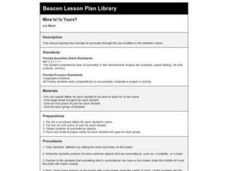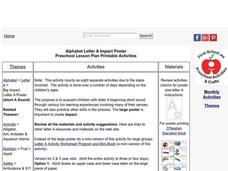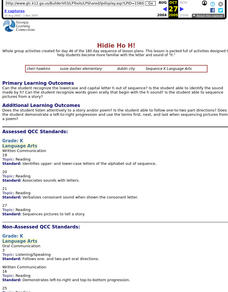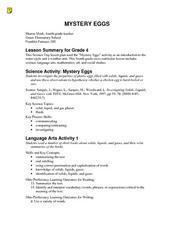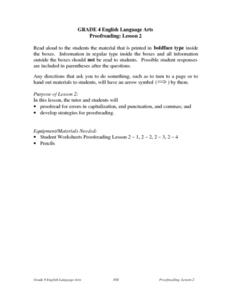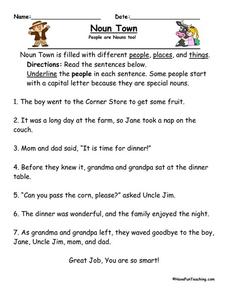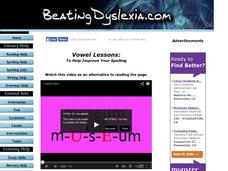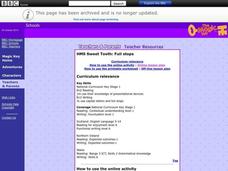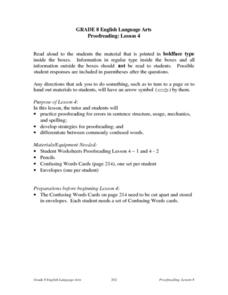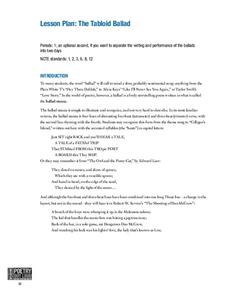Curated OER
Literal Meaning of Reading
Students demonstrate literal meaning of a fiction book. For this reading comprehension lesson, students listen to the book, If You Give a Mouse a Muffin and practice the "m" sound during the read aloud. Students answer questions about...
Curated OER
ESOL Alphabet Recognition
Students recognize, state, read and write the alphabet (upper and lower cases) and numbers. They identify the letters, pronounce their name with the letters out of sequence and in sequence.
Curated OER
Create An Illuminated Alphabet Word Book
Young scholars develop a class alphabet book. For this visual arts lesson, they draw a letter of the alphabet that is illustrated with animals or objects in the style of medieval illuminated alphabet books. They write a sentence about an...
Curated OER
Mine Is! Is Yours?
First graders engage in a lesson which teaches the concept of symmetry through the use of letters in the student's name. They use a piece of yarn to see if they can make symmetrical pieces out of their own names.
Curated OER
No Title
Students are introduced to and practice with the letter "A" in beginning short sound words through various experiences involving many of their senses. They interact with flash cards that contain the letter "A" sound including animals,...
Curated OER
Hidie Ho H!
Students become more familiar with the letter and sound of h by using the poem, Humpty Dumpty. They are given a sequencing sheet, a pair of scissors, crayons, and a piece of construction paper and told to put pictures in the correct order.
Curated OER
Mystery Eggs
Students investigate the properties of plastic eggs filled with solids, liquids, and gases and use these observations to hypothesize whether a chicken egg is hard-boiled or raw.
Curated OER
Nouns in a Story
Students, assessing a variety of formatting tools with Microsoft Word, utilize a bank of vocabulary words to make a personal dictionary of nouns. They classify nouns for people, places, things and ideas and separate them into common and...
BBC
The Patchworker - Sentences Making Sense
An entertaining and educationally sound lesson on sentence structure is here for you. Young readers play an online game called "The Patchwork Game" where they must patch together a series of words in order to create a complete sentence....
Curated OER
Proofreading: Lesson 2
Identify and develop strategies for proofreading with your class. They read and identify the grammar rules for capitalization, end punctuation, and commas, correct errors as a class, and complete three worksheets. This resource includes...
Have Fun Teaching
Noun Town
Welcome to noun town where you will meet a number of different people, places, and things! Have kids practice identifying nouns by completing a great set of worksheets. There are 13 worksheets in the packet and each one provides practice...
Curated OER
Vowel Lessons: To Help Improve Spelling
There are a few things every good speller knows: spelling rules, vowel sounds, and word endings. Help your learner with dyslexia become a more efficient speller with a few tips from a dyslexia expert. Included in the lesson is a video,...
Pyro Innovations
Beach Exploration
Little ones will absolutely love this lesson. It's all about the beach and what they can find while sifting through the sand. A large bucket of sand filled with hidden items is brought into the classroom. Learners will discuss what kinds...
Willow Tree
The Pythagorean Theorem
There isn't a more popular geometry formula than the Pythagorean Theorem! Learners understand the special side relationships in a right triangle. They use the Pythagorean Theorem to find missing sides and to solve problems. They begin...
Curated OER
Converting Frenzy
Gain practice converting between metric units of volume and mass. The class goes over the procedures for making the conversions as a whole. The strategy used here includes making charts that show the relationships between the...
Curated OER
Double Jeopardy-Homophones
Second graders identify homophones as words that sound alike but have different meanings. They, given a pair of homophones, are to explain the meanings of the words using gestures, role playing, or drawing a picture with their partner.
BBC
Full Stops
This is an incredibly detailed and thorough plan. It is all about full stops - which is the British way of saying, "Periods." First-year learners practice the skill of knowing when to use a period, and understand what periods are meant...
BBC
Sweet Tooth - Full Stops
Young writers engage in a lesson which reinforces the concept of when to use periods, "full stops" as they're called, when writing. There is a terrific online activity built into the plan which gives the kids valuable practice, then a...
Curated OER
Proofreading: Lesson 4
Examine the key strategies to proofreading a piece of writing for errors in sentence structure, usage, mechanics and spelling. Eighth graders practice putting into correct passage commonly confused words (too, two, to) when writing to a...
Curated OER
Idea Organizer
In this idea organizer worksheet, young scholars complete an outline for their essay by filling in their topic, topic sentence, four subtopics, and three ideas supporting the subtopic.
Poetry Out Loud
The Tabloid Ballad
What do the theme song from Gilligan's Island, the nursery rhyme "The Owl and the Pussy-Cat," and the poem "The Shooting of Dan McGrew" all have in common? Why, they're ballads of course! Challenge your young balladeers to compose their...
Ware County Schools
Simple Directions
When teaching someone how to do something, it's important to give clear directions. Your youngsters can practice their skills by completing these worksheets meant to help learners describe the steps in a process. It's not just any...
Peace Corps
Defining Culture
How has culture shaped you? Middle and high schoolers examine different aspects of one's culture, including religious beliefs, social customs, and family traditions, and discuss the ways that their personalities have been formed by these...
02 x 02 Worksheets
Symmetry
Get learners' minds rotating and reflecting while looking for symmetry. Pupils investigate figures to determine the number of lines of symmetry and if the figure has rotational symmetry. Classmates work together in groups to find out the...



